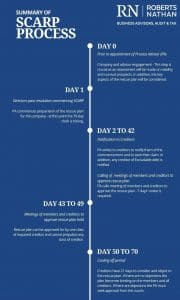News
How SCARP Helps Small Companies Settle Debts with Creditors

SCARP, the Small Companies Administrative Rescue Process is a restructuring process similar to the Examinership process in Ireland, used to restructure companies in, or facing financial distress.
Examinership, whilst it has saved thousands of jobs over the last thirty years, is expensive and complex for many small and medium sized companies.
SCARP is the government’s response to the need to provide a restructuring process that is cost effective and more accessible to micro, small and medium sized companies.
Its introduction is timely, as we emerge from Covid-19 many businesses are facing difficult and uncertain trading conditions.
With government Covid-19 supports now tapering off, the commencement of repayment of warehoused tax liabilities, the impact of the war in Ukraine, increased energy costs, raw material shortages and labour supply issues, businesses are now heading towards what one might consider a perfect economic storm.
Whilst the indications are ‘the economic headwinds’ will be short lived; companies and businesses will have to weather these storms and unfortunately some will not survive.
SCARP provides a restructuring tool that will allow companies to restructure their debts whilst continuing to trade. The restructuring plan once finalised and agreed with creditors becomes legally binding.
Key considerations
Who is SCARP available to:
SCARP is available to companies where:
- Turnover does not exceed €12 million.
- The balance sheet total does not exceed €6 million.
- The average number of employees does not exceed 50.
This captures approximately 98% of all Irish businesses.
In addition to be eligible a company must:
- be unable or is likely to be unable to pay its debts.
- not be in liquidation or have a receiver appointed.
- have not used the process or had an examiner appointed in the last five years.
Key features of the process
- The process is led by a qualified Insolvency Practitioner (IP). The IP will be appointed as Process Advisory (PA) and will be tasked with formulating a rescue plan for the company.
- The process will have a defined timeline lasting up to 70 days.
- There is no automatic court protection from creditors once a company enters the process. The PA can seek this court protection once appointed.
- A rescue plan is approved when a 60% majority in number and a majority in value of one class of creditor approves the scheme.
- There is the ability to repudiate onerous contracts (e.g. leases).
- State debt is classified as ‘Excludable Debt’. Essentially the state creditors (e.g. Revenue) has the option to opt out of the process. It has 14 days from the giving of notice to opt out, if there is no objection within that timeframe, Revenue may be included in the rescue plan.
- A rescue plan may require additional investment in the company. There is the ability to fund the plan over a period of time, subject to the approval of creditors.
- The PA is obliged to report to the Officer of the Director of Corporate Enforcement (‘ODCE’) on the historical conduct of the directors of the company.

Summary
In essence, SCARP is a process that, if successful, will ultimately be an agreement between a company and its creditors to settle its debts.
It is a very welcomed process that allows businesses to restructure their balance sheets to enable them to protect employment and to continue to trade.
Fundamentally the company must have a reasonable prospect of survival to avail of the process. Early-stage action and intervention is key to a successful outcome in any scenario where companies are facing financial distress and/or liquidity issues. This affords businesses the time to consider all available options.
We at Roberts Nathan have significant formal and informal restructuring experience to help you navigate through these challenging times, so if you would like to discuss the above or any other issues or concerns facing your business, please contact Derek, or get in touch with us at derek.dervan@robertsnathan.com
